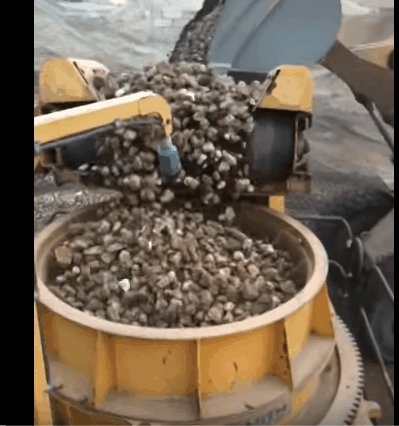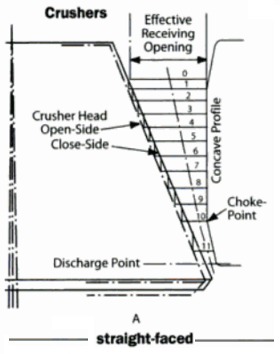Effect of Feed on Crusher Performance

If the ore feed to any gyratory or jaw crusher consisted entirely of large cubes or spheres of a size that would just barely enter the crushing chamber, the crusher could not be expected to produce anything like its normal rated capacity because the upper part of the crusher could not shatter the large pieces […]
Jaw Crusher Liner Plate Design & Profile Shapes

Straight Jaw Plates: A shows a diagram of a standard type of Blake crusher with regular or straight jaw plates. This type of plate has been the standard from the time of its inception, emulating, in this respect, the straight concaves in the gyratory machine. And it will be noted that the theoretical action in this straight-plate […]
Gyratory Crusher Concaves

Concaves on the right illustrate the cross section of a typical gyratory crusher, while the left illustrates the same crushing chamber, except that, in place of the straight-face concave, the non-choking type has been substituted. For the sake of direct comparison we have shown the same discharge setting in both diagrams, although a closer setting would be permissible […]
Rock Crusher History

History tells us, it was in 1830, the first US patent was issued on a rock crushing machine. It covered a device which, in a crude way, incorporated the drop hammer principle later used in the famous stamp mill, whose history is so intimately linked with that of the golden age of mining. In 1840, another patent was […]
Crusher Concave Profiles

When used for primary or coarse secondary crushing service, the type of crusher described is usually fitted with the style of concave shown on the upper left. These are known as “standard” or straight-face concaves, which have been the standard type of liner ever since the gyratory crusher came into popular use. The distinguishing features of […]
High Capacity Crusher

When the non-choking feature was being applied to existing crushers of the gyratory type, it was found that in several crushing machines, the attendant reduction in receiving opening could be partially offset by sloping the straight portion of the concaves at a wider angle than that for which the top shell was originally designed, because […]
